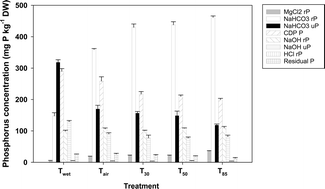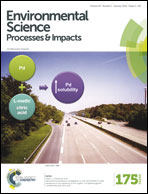The severity of sediment desiccation affects the adsorption characteristics and speciation of phosphorus†
Abstract
Phosphorus is an important nutrient for plants and algae, and can be the limiting nutrient in aquatic ecosystems. However, oversupply can lead to significant water quality issues. The largest source and sink of P in most aquatic systems is the sediment. As a consequence of drought, in many places sediments that normally would have remained inundated are now being desiccated. Based on previous studies, it is often difficult to predict what impact drying will have on the cycling of P. This is because most of these studies have looked at drying across a chronosequence in the field, where there may be differences in sediment composition or microbial community structure. In this paper we present the results of a study where sediment was exposed to progressively more severe drying in the laboratory – starting with wet sediment, followed by air drying and then sequential oven drying at 30, 50 and 85 °C. Drying resulted in a shift in P speciation, notably with an increase in NaHCO3-extractable reactive P and a decline in NaHCO3-extractable unreactive P, likely indicating an increase in bioavailable, easily exchangeable P. Drying also resulted in a decline in the microbial-P fraction. Drying significantly affected the P adsorption characteristics of the sediment. The total amount of P adsorbed by the sediment and the linear adsorption co-efficient both declined, while the amount of native P adsorbed to the sediment and the equilibrium P concentration both increased. Drying also affected iron speciation with a shift from more reactive oxalate-extractable Fe to more recalcitrant citrate–dithionate–bicarbonate-extractable Fe, suggesting an increase in iron crystallinity and hence decrease in P adsorption capacity. The increase in crystallinity is consistent with Fe EXAFS results, which showed that drying resulted in an increase in edge-sharing neighbours. We hypothesise that the shifts in P speciation, the decline in P adsorption capacity, the increase in the equilibrium P concentration, as well as the death of micro-organisms (as evidenced by a decline in microbial P) on drying all contribute to the Birch effect – the initial pulse of P and/or N upon inundation of dried soils or sediments.


 Please wait while we load your content...
Please wait while we load your content...